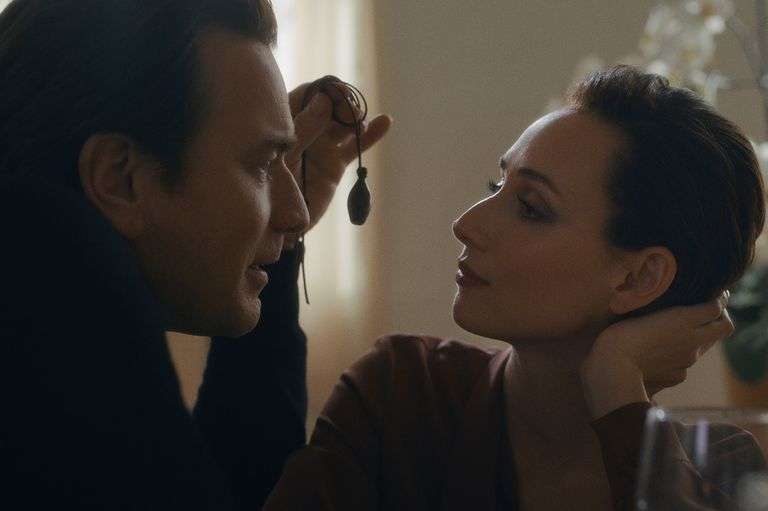
Halston’s Rebecca Dayan on Embodying Elsa Peretti
As Edie Sedgwick was to Warhol and Yoko was to John, so too was Elsa Peretti to Halston. Peretti, an Italian model-turned-actress-turned-wildly successful jewellery designer, began her artistic career as a muse to fashion designer Halston. Alongside Liza Minelli, Peretti inspired many of the brand’s most lauded designs, including those famous caftans. The model and designer were close friends, attending parties at Studio 54 and reportedly eating dinners of “caviar, baked potato, and cocaine.” Peretti crafted her first-ever jewellery pieces for Halston’s shows, and it was, in fact, Halston who originally helped broker Peretti’s design deal with Tiffany & Co. This partnership eventually made Peretti one of the most successful jewellery designers in the world.
The Halston-Peretti relationship is chronicled in the new Ryan Murphy-produced Netflix show, Halston. French-born actress and former model Rebecca Dayan plays the Elsa to Ewan McGregor’s Halston, as the show charts the pair’s evolving dynamic through the 1970s and ’80s. Though Dayan never got to meet Peretti (who passed away this March), she used books, interviews, magazine clippings, and fashion show footage to embody the influential figure.
Here, Lakkars magazine spoke with Dayan about her approach to playing Elsa, her hidden similarities to the famed jeweller, and, somewhat surprisingly, glass blowing.

Do you think that your personal style changed at all after filming the series?
[Elsa and] I always had a bit of a similar approach to dressing, which is elegant but casual… I just called myself elegant—great [laughs]. You know, very put together, but not stuffy—cool accessories and things like that. So, not so different.Aside from fashion, did you find any other similarities between yourself and Elsa?
We were not totally different in the sense that she modelled; I modelled. She comes from Italy; I come from the South of France. She moved to New York to pursue her dreams; I’m here to pursue my dreams. So, in that sense, there were a lot of things that were similar, and in character, I also recognized this uncompromising, fiery personality was something that I can be like.
I found it captivating to watch the scenes set in Studio 54, as the environment was the complete opposite of our past year. What was it like, emotionally, filming those scenes during COVID?
Before you call action, everyone is on the set that looks like Studio 54, with all the lights and everything, wearing shields and masks. It’s very strange—like, half-naked people wearing shields and masks. So, it was a bit awkward at first and a bit scary, but, emotionally, it was amazing. It was very liberating. And obviously, [viewers] see a montage of it, but we danced a lot and we had all these moments. It felt real for the eight minutes between action and cut. It felt like we were really at a party.

I wanted to talk to you a bit about muses, and how Elsa was very much Halston’s muse, as was Liza Minelli. What do you think it means to be a muse?
I think it’s more than just inspiration. It’s also someone who works with you, who pushes you, challenges you. I feel like there were moments that Halston couldn’t do things without Elsa and Elsa couldn’t do things without Halston. There’s very much that dynamic.
Do you think that still exists?
I think in some way. It might not be exactly the same, or it might not be in the same form, but I think every artist needs muses, and it doesn’t necessarily come in the form of a person.
In terms of filming, were there any scenes you particularly enjoyed shooting?
In episode three—the making of the [Halston perfume] bottle, and what it was like for Elsa to be creative and to have this opportunity to show her talent. That was really fun for me.
That perfume bottle scene involves a fair amount of glass blowing. Did you need to learn anything about that process?
Funnily enough, I grew up in the South of France really close to a glassblowing town. So, when I was a kid, I went a lot to the glassblower, because the school would take us on a field trip to the glass blowing place. So, I had a sense of it and when I went for that scene, it was like, “I know this.”

Though you’ve lived in New York for a while now, did this series change your perceptions about the city at all?
No, I don’t think it changed it. I think the show resembled more the idea that I had before moving to New York—probably because of all the films that I had watched, and all the people I admired were from that era. So, maybe it was actually more like what I had imagined than what it ended up being.
Last question—what would you like viewers to take away from watching Halston?
I think it’s very modern and contemporary and important. Especially right now, everyone’s obsessed with fame and building a brand and making a name for themselves—that cult of individuality. It’s a good cautionary tale of the dangers of it and also good insight on what creativity is and how, when you have something that you love so much and that you’re so passionate about, you have to treat it with a lot of care and try to not compromise too much and stay true to who you are.

Magazine launched for helping women for success. Lakkars has always served and worked efficiently towards women empowerment, we have blossomed into America’s most-read fashion magazine.


